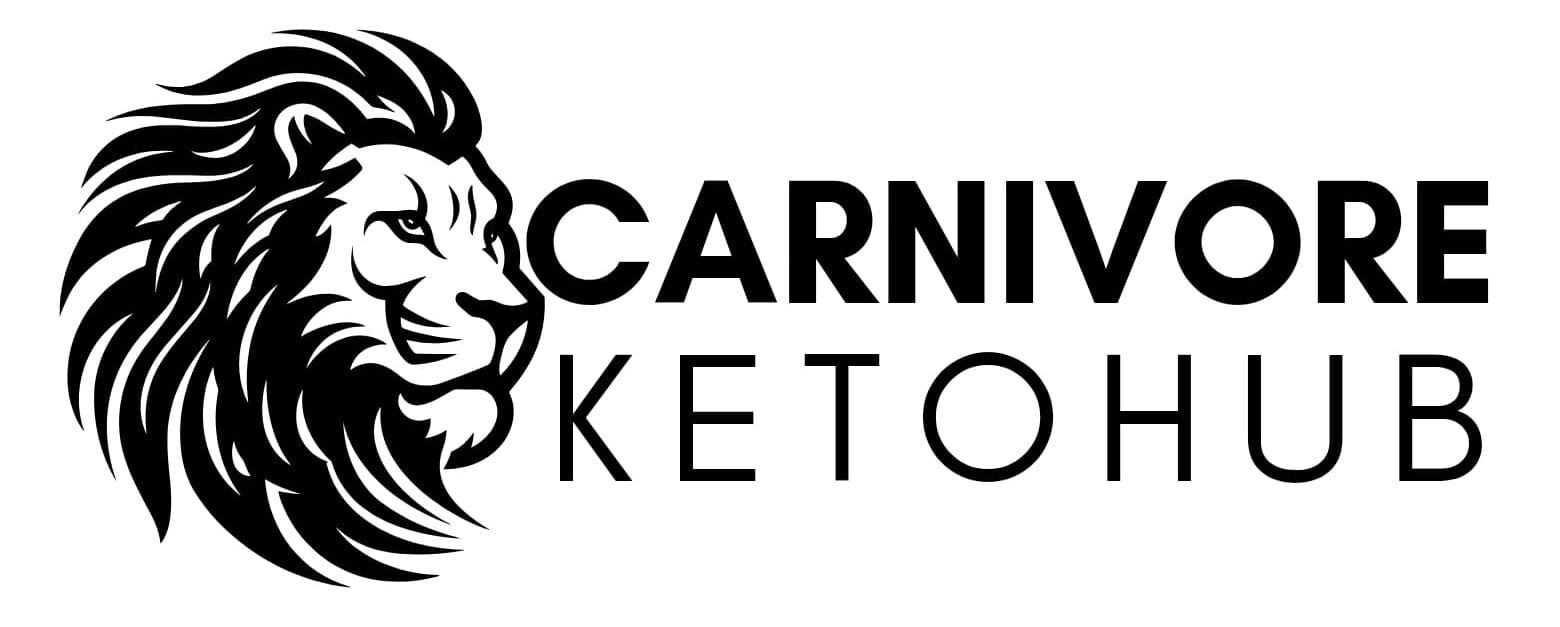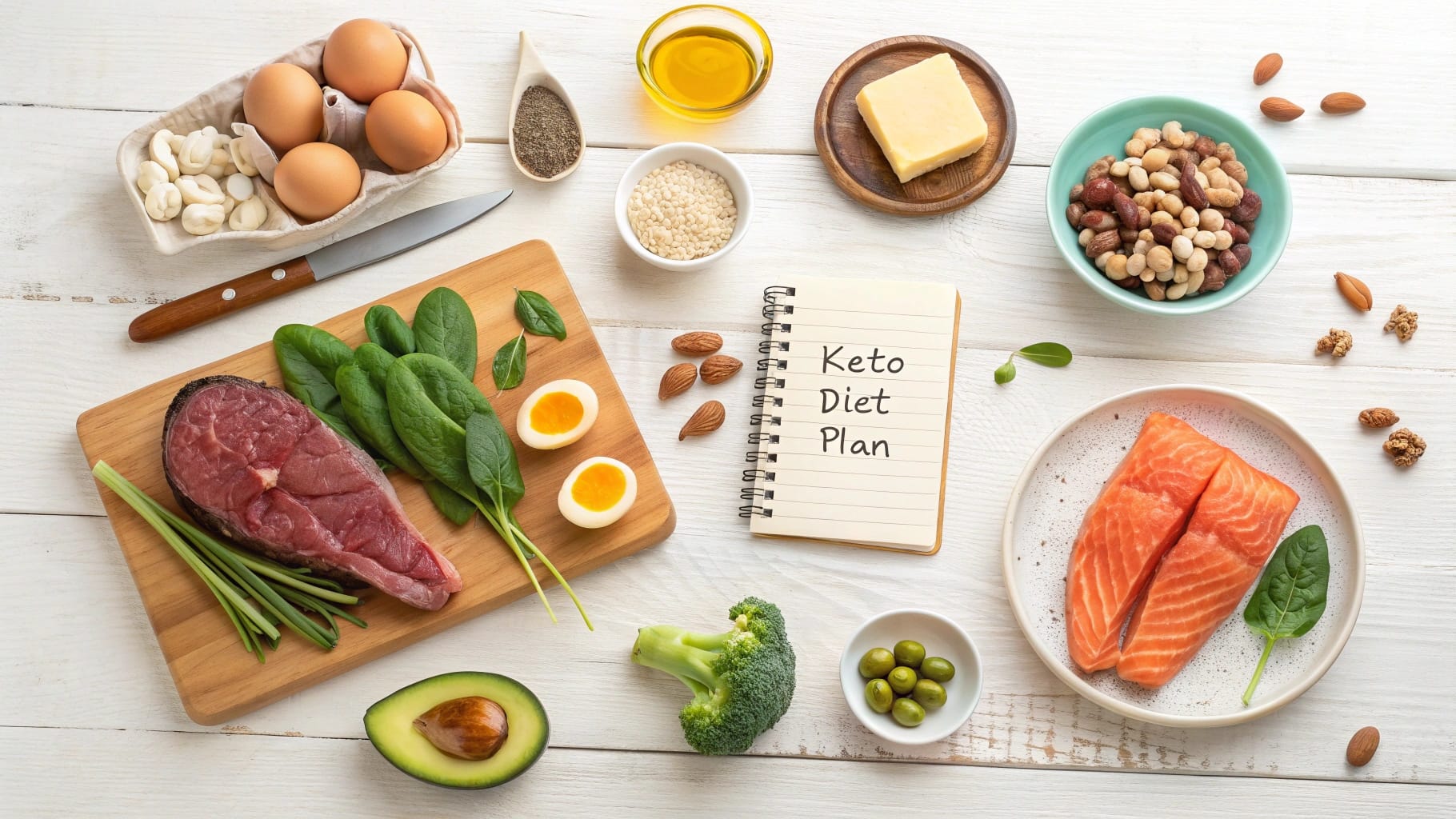Keto Diet Plan: The Ultimate Guide for Beginners (Includes 7-Day Meal Plan)
Ready to Finally Master Your Keto Diet Plan?
The ketogenic diet has exploded in popularity—and for good reason. This powerful dietary approach has helped countless people transform their health, lose weight, and regain control of their metabolism. But despite its simple premise (low-carb, high-fat), knowing exactly how to structure your meals and plan ahead can make all the difference between success and frustration.
Forget confusion and overwhelm. In this comprehensive guide, we’ll walk you through creating a simple, effective keto diet plan, complete with sample menus, shopping tips, and practical strategies to help you achieve your goals. Whether you’re brand new to keto or looking to refine your approach, this roadmap will set you up for success.
Before starting, it’s helpful to understand the “why” behind the keto diet, including its benefits for metabolic health and weight loss. Learn more about what the keto diet is and how it works here.
Table of Contents
Keto Fundamentals: The Building Blocks of Your Plan
Macros
The ketogenic diet revolves around a specific macronutrient distribution that shifts your metabolism toward fat-burning. The typical breakdown includes:
- Fat: 70-75% of daily calories
- Protein: 20-25% of daily calories
- Carbohydrates: 5-10% of daily calories (usually 20-50g net carbs per day)
Understanding net carbs is essential: simply subtract fiber from total carbs to calculate them. This distinction matters because fiber doesn’t significantly impact blood sugar or ketosis.
Ketosis
Ketosis is the metabolic state where your body burns fat (rather than glucose) for fuel. Entering ketosis requires restricting carbohydrates to typically less than 20-50g of net carbs per day. This carb restriction forces your body to produce ketones from fat, which become your primary energy source.
According to research published in the New England Journal of Medicine, ketosis offers numerous benefits beyond weight loss, including improved insulin sensitivity and reduced inflammation.
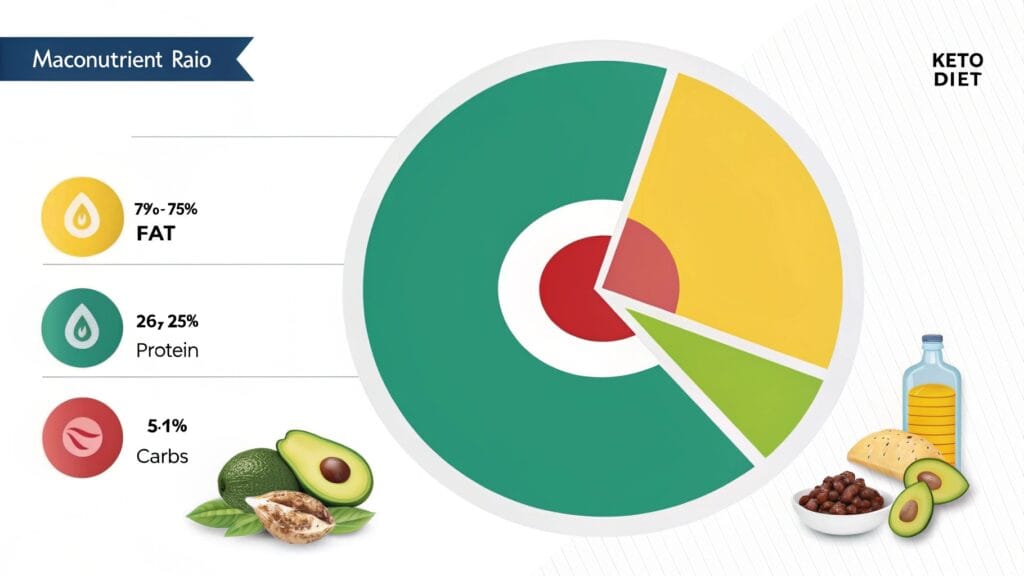
Allowed Foods
Focusing on the right foods makes your keto journey both enjoyable and sustainable. Here’s what belongs on your plate:
- Meats: Beef, pork, lamb, poultry, game meats
- Fish & Seafood: Salmon, sardines, mackerel, shrimp, crab
- Eggs: A versatile keto staple
- Healthy Fats: Olive oil, coconut oil, avocado oil, butter, ghee
- Low-Carb Vegetables: Leafy greens, broccoli, cauliflower, zucchini, peppers
- Dairy: Full-fat cheese, cream, yogurt (unsweetened)
- Nuts & Seeds: Macadamias, almonds, walnuts, flax seeds, chia seeds (in moderation)
For a comprehensive list of animal-based options that form the foundation of many successful keto plans, see our Carnivore Diet Food List.
Foods to Avoid
Just as important as knowing what to eat is knowing what to avoid:
- Sugars: Table sugar, honey, maple syrup, agave, and most fruits
- Grains: Wheat, rice, corn, oats, and all products made from them
- High-Carb Vegetables: Potatoes, carrots, beets
- Processed Foods: Especially those with added sugars or unhealthy fats
- Legumes: Beans, lentils, chickpeas
- Most Fruits: Except small portions of berries
Building Your Personalized Keto Plan: Step-by-Step
Calculate Your Macros
Everyone’s keto journey is unique, as personal factors like age, gender, weight, height, activity level, and goals all influence your ideal macronutrient intake. While some people thrive on the standard keto macros mentioned earlier, others may need adjustments.
For accurate calculations, consider using the Mayo Clinic’s calorie calculator as a starting point for total calories, then apply the keto percentages (70-75% fat, 20-25% protein, 5-10% carbs).
Choose Your Foods
With your macros established, it’s time to select foods that align with your nutritional needs and preferences. Focus on:
- Nutrient Density: Prioritize whole, unprocessed foods rich in vitamins and minerals
- Variety: Include different protein sources, vegetables, and fats to ensure broad nutritional coverage
- Personal Enjoyment: Select foods you genuinely enjoy eating—sustainability depends on satisfaction
- Practicality: Consider your lifestyle, cooking skills, and time constraints
Plan Your Meals & Snacks
Decide how many meals work best for your lifestyle and preferences. Many keto enthusiasts naturally gravitate toward intermittent fasting patterns due to ketosis’s natural appetite-suppressing effects. Common meal structures include:
- Three traditional meals: Breakfast, lunch, and dinner
- Two meals plus a snack: Often lunch and dinner with a small snack
- One large meal and one small meal: Popular with intermittent fasting approaches
For even more guidance on combining keto with time-restricted eating, check out our guide on intermittent fasting with keto and carnivore approaches.
Prepare for “Keto Flu”
As your body adapts to burning fat instead of carbohydrates, you might experience temporary symptoms collectively known as “keto flu.” These can include fatigue, headaches, irritability, and muscle cramps—primarily caused by electrolyte imbalances as your body sheds water and minerals.
Electrolyte balance is crucial when starting keto. Learn more about managing “Keto Flu” symptoms with electrolytes in our comprehensive guide What is Keto Flu: Symptoms and Causes.
According to a study published in Frontiers in Nutrition, proper electrolyte supplementation can significantly reduce adaptation symptoms and improve adherence to ketogenic diets.
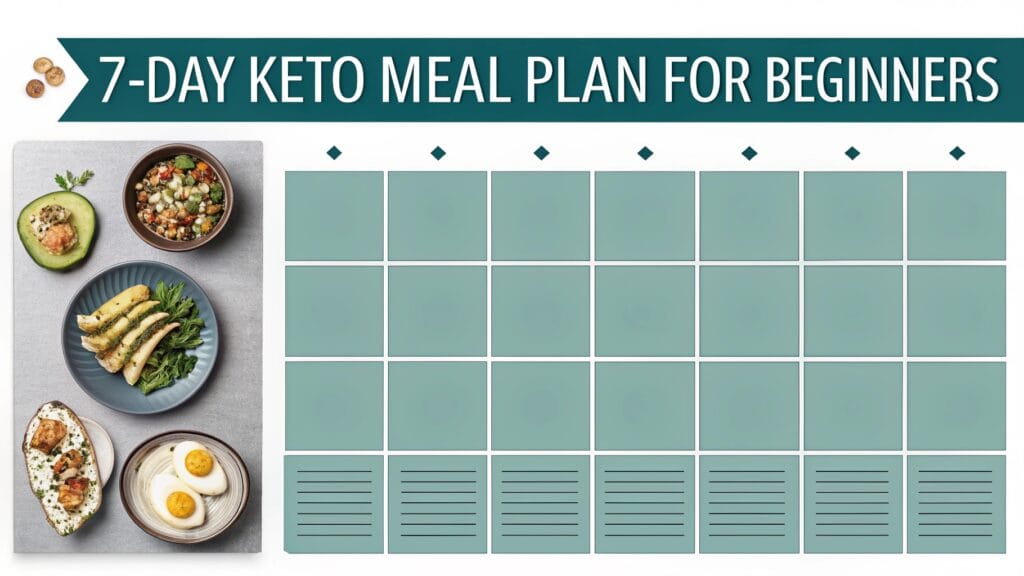
Sample Keto Meal Plans
7-Day Beginner Keto Meal Plan
Below is a simple, straightforward meal plan to get you started. Feel free to adjust portions based on your personal macros and swap meals according to your preferences:
Day 1:
- Breakfast: Scrambled eggs with spinach and cheddar cheese
- Lunch: Tuna salad with mayonnaise on a bed of mixed greens
- Dinner: Keto Carnivore Ground Beef Skillet with cauliflower rice
Day 2:
- Breakfast: Keto smoothie (almond milk, avocado, protein powder, spinach)
- Lunch: Chicken Caesar salad (no croutons)
- Dinner: Baked salmon with asparagus and butter
Day 3:
- Breakfast: Carnivore Breakfast (eggs and bacon)
- Lunch: Beef lettuce wraps with avocado and sour cream
- Dinner: Keto Carnivore Pork Chops with roasted brussels sprouts
Day 4:
- Breakfast: Keto chia pudding with coconut milk and berries
- Lunch: Chef salad (turkey, ham, cheese, eggs, greens)
- Dinner: Keto Carnivore Steak with buttered broccoli
Day 5:
- Breakfast: Avocado baked eggs
- Lunch: Spinach salad with grilled chicken, feta, and olive oil dressing
- Dinner: Keto Carnivore Taco Skillet (using lettuce wraps)
Day 6:
- Breakfast: Cream cheese pancakes with a few berries
- Lunch: Chicken soup with low-carb vegetables
- Dinner: Carnivore Swedish Meatballs with zucchini noodles
Day 7:
- Breakfast: Bulletproof coffee and hard-boiled eggs
- Lunch: Grilled chicken Caesar wrap using lettuce as the wrap
- Dinner: Baked cod with lemon butter and asparagus
Notes on Customization:
- Adjust portions based on your calculated macros
- Add fat as needed (olive oil, butter, avocado)
- Include zero-carb snacks as needed within your macros
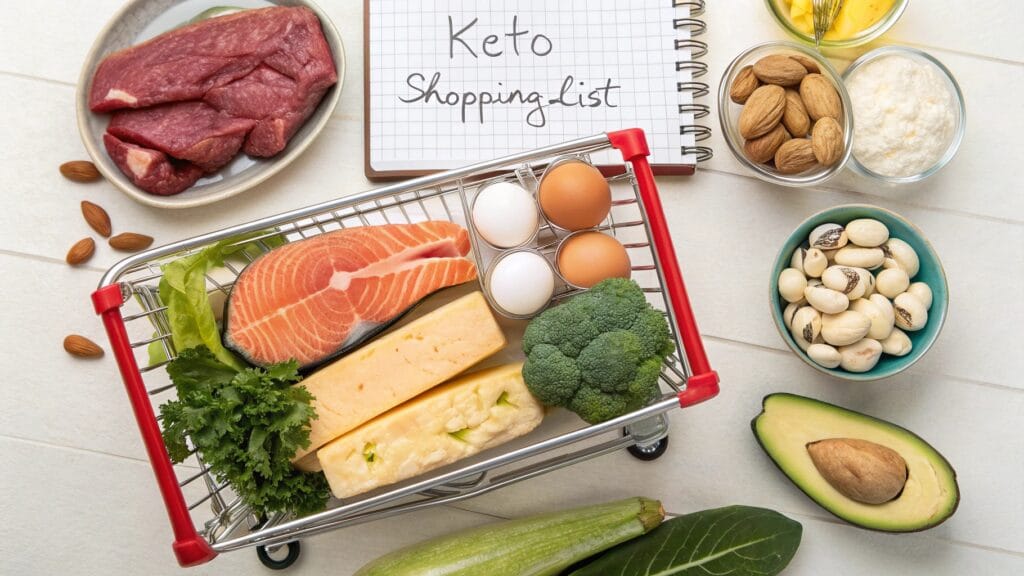
Practical Implementation: Shopping & Meal Prep
Your Keto Shopping List
A well-stocked kitchen sets you up for success. Here’s a comprehensive keto shopping list organized by category:
Proteins:
- Quality meats (beef, pork, lamb, chicken, turkey)
- Fish and seafood (salmon, tuna, shrimp)
- Eggs
- Full-fat cheese varieties
Fats:
- Olive oil, avocado oil, coconut oil
- Butter, ghee
- Avocados
- Heavy cream
- Nuts and seeds (in moderation)
Low-Carb Vegetables:
- Leafy greens (spinach, kale, lettuce)
- Cruciferous vegetables (broccoli, cauliflower, brussels sprouts)
- Zucchini, bell peppers, celery, cucumber
- Mushrooms, asparagus
Dairy:
- Full-fat greek yogurt (unsweetened)
- Cream cheese
- Sour cream
- Hard and soft cheeses
Other Essentials:
- Herbs and spices (salt, pepper, garlic powder, etc.)
- Broth/stock (beef, chicken, bone broth)
- Coffee, tea
- Almond flour, coconut flour (for occasional keto baking)
For a stricter animal-based approach to shopping, see our Carnivore Diet Food List.
Meal Prep Tips for Success
Strategic meal preparation dramatically increases your chances of keto success. According to research from the International Journal of Behavioral Nutrition and Physical Activity, meal planning is associated with better dietary quality and reduced obesity.
Here are actionable meal prep strategies for keto success:
- Batch cook proteins: Grill several chicken breasts or cook a large roast for multiple meals
- Prepare versatile basics: Hard-boiled eggs, cooked bacon, and pre-cooked ground beef
- Chop vegetables in advance: Store in containers for quick meal assembly
- Make fat bombs: Prepare keto-friendly high-fat snacks for busy days
- Portion properly: Use containers to pre-portion meals according to your macros
- Label everything: Include the date and basic macros on meal prep containers
- Schedule a dedicated prep day: Sunday afternoon works well for many
For more meal ideas and recipes, explore our collection of Carnivore Diet Recipes and Keto Carnivore Recipes.
Adapting Your Keto Plan for Specific Needs
Dairy-Free Keto
Many people experience improved results when eliminating dairy. To adjust your keto plan to be dairy-free:
- Replace butter with ghee (which has casein and lactose removed) or coconut oil
- Use coconut cream instead of heavy cream
- Choose coconut yogurt over dairy yogurt
- Emphasize other fat sources like avocados, olives, and nuts
- Incorporate more coconut products (milk, cream, butter)
Harvard Health Publishing notes that some individuals see reduced inflammation when removing dairy from ketogenic diets.
Higher Protein Keto
Also called “modified keto,” this approach slightly adjusts the macro ratios to accommodate more protein:
- Fat: 60-65% of calories (down from traditional 70-75%)
- Protein: 30-35% of calories (up from traditional 20-25%)
- Carbs: Still 5-10% of calories
This variation works well for:
- Active individuals and those who strength train
- People who struggle to feel satisfied on traditional keto
- Those looking to preserve muscle mass during weight loss
Budget-Friendly Keto
Eating keto doesn’t have to break the bank:
- Focus on cheaper cuts of meat (chicken thighs, ground beef, pork shoulder)
- Buy in bulk when items go on sale
- Utilize eggs as an economical protein source
- Choose frozen vegetables when fresh are expensive
- Shop at discount grocery stores and farmer’s markets
- Consider buying a quarter or half of a cow directly from a local farm
“Lazy” Keto
This simplified approach focuses primarily on carb restriction without meticulously tracking fat and protein:
- Track only net carbs, keeping them under 20-30g daily
- Eat intuitively for protein and fat
- Focus on whole, keto-friendly foods
- Still avoid high-carb foods entirely
While not ideal for everyone, this approach can make keto more sustainable for those who find detailed tracking overwhelming.
Beyond Keto: Exploring the Carnivore Plan
For those seeking maximum simplicity and potentially enhanced results, the carnivore diet represents the ultimate extension of keto principles. This approach eliminates all plant foods, focusing exclusively on animal products:
- Consists primarily of meat, fish, eggs, and sometimes select dairy
- Naturally achieves ketosis through near-zero carb intake
- Removes all potential plant antinutrients and irritants
- Provides complete protein and bioavailable nutrients
- Simplifies meal planning and food choices dramatically
The carnivore diet takes the principles of low-carb to the extreme by focusing solely on animal foods. Learn more about the science behind its effectiveness for metabolic health in our article on How to Improve Insulin Sensitivity.
Ready to explore the simplest approach? See our Carnivore Diet Food List.
Supplements to Support Your Keto Plan
While whole foods should form the foundation of your nutrition, certain supplements can help optimize your keto journey, especially during the transition period.
Electrolytes: Essential for Keto Success
Electrolyte supplementation is arguably the most important consideration when starting keto. As insulin levels drop, your kidneys excrete more sodium, which can disrupt your entire electrolyte balance. Key electrolytes to monitor include:
- Sodium: 3,000-5,000 mg daily
- Potassium: 1,000-3,500 mg daily
- Magnesium: 300-500 mg daily
Learn everything you need to know about optimizing electrolytes on a low-carb diet in our comprehensive guide to Carnivore Diet Electrolytes.
Optional Support
Depending on your specific needs, you might consider:
- Omega-3 fatty acids: For optimal inflammatory balance, especially if not regularly consuming fatty fish. Check out our guide on Omega-3 Benefits and the Best Omega-3 Supplements.
- Vitamin D: Particularly important if you have limited sun exposure or live in northern latitudes.
- Magnesium: Often beneficial beyond basic electrolyte needs for sleep, muscle function, and stress management.
- Adaptogenic herbs: Some people find adaptogens helpful for managing stress during dietary transitions. Learn more in our article on What Are Adaptogens.
For a comprehensive look at supplementation strategies, see our guide on Carnivore Diet Supplements.
According to research published in the Journal of the International Society of Sports Nutrition, proper supplementation can enhance performance and reduce side effects during adaptation to ketogenic diets.
Important Considerations & Medical Disclaimer
Keto Flu
During the first few days to weeks of keto, your body undergoes significant metabolic changes that can lead to temporary discomfort known as “keto flu.” Symptoms typically include fatigue, headache, irritability, difficulty focusing, muscle cramps, and digestive issues.
Most symptoms can be alleviated with proper electrolyte supplementation, adequate hydration, and sufficient fat intake. Learn more in our detailed article about What is Keto Flu: Symptoms and Causes.
Consistency is Key
The metabolic benefits of ketosis require consistent carbohydrate restriction. Even occasional high-carb meals can interrupt ketosis and delay adaptation. Give yourself at least 3-4 weeks of strict adherence before making any major adjustments to your approach.
Patience
While some people experience rapid results on keto, lasting metabolic healing takes time. Focus on consistent implementation rather than seeking overnight transformation. Track non-scale victories like improved energy, better mental clarity, reduced cravings, and better sleep quality.
MEDICAL DISCLAIMER
The information provided in this article is for educational purposes only and should not be construed as medical advice. Always consult with a qualified healthcare provider before starting the ketogenic diet or any new dietary regimen, especially if you have existing health conditions, take medications, or are pregnant or nursing. The ketogenic diet may not be suitable for everyone.
Conclusion: Your Path to Keto Success Starts Here
A clear, well-structured keto plan forms the foundation of success with this powerful dietary approach. By understanding the fundamental principles of ketogenic nutrition, calculating your personal macros, selecting appropriate foods, and implementing practical strategies like meal prep, you’re setting yourself up for sustainable results.
Whether you choose to follow a standard ketogenic diet or explore the simpler carnivore approach, the fundamentals remain the same: restrict carbohydrates, consume adequate protein, and use fat as a lever for energy and satiety.
Remember that your keto journey is unique. Be willing to adjust, experiment, and refine your approach based on your body’s feedback and your personal goals. With consistency and patience, the ketogenic lifestyle can transform not just your body composition but your overall health and relationship with food.
What does your daily keto plan look like? Share your best tip for planning in the comments below!
This post may contain affiliate links. Please read our disclosure for more information.
Enjoy, Review – We Value Your Opinion!
There are no reviews yet. Be the first one to write one.
